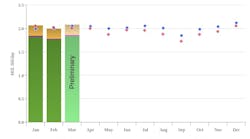Sam Fletcher
OGJ Senior Writer
Oil prices were sharply volatile entering the second quarter of 2009 and are likely to remain "within a rising trend," said Paul Horsnell, managing director and head of commodities research at Barclays Capital Inc. in London.
In an Apr. 1 report, Horsnell said after 5 successive days in which front-month benchmark US light, sweet crudes hit intraday highs of $54-55/bbl, prices then retrenched over the next 3 days to lows some $7/bbl below that. "That pattern has been symptomatic of trading over the past 4 months," he said, "with cycles of higher prices being sold into on recurrent macroeconomic worries and weak data. Throughout those cycles, the tension between the short term and the medium term has been a significant source of volatility. During periods of calmer or more constructive macroeconomic data flow, the widespread view that supply-side damage means that prices are too low on medium- and long-term supply grounds gains footing, but when the fear returns, the view that prices are too high on short-term demand grounds motivates further selling."
Horsnell said, "The strong volatility associated with that tension seems unlikely to disappear in the current quarter, and we would expect to see several more of these episodes of 10%-plus up and down moves over very compressed time periods. Rather than the swings themselves, the more important feature is whether there is any trend in the mid-ground for this particular tug-of-war."
Horsnell said, "The question is whether prices [are] oscillating within a tunnel that is heading upwards, is flat, or is heading lower. In other words, will the quarter see in broad terms higher highs, lower lows, or a flat trend?"
In terms of the average price for the Organization of Petroleum Exporting Countries' basket of 12 reference crudes, Horsnell said, "The low for the current cycle is $33.36/bbl set in December, the high is $50.77/bbl set last week, and the latest value is $46.65/bbl. We would doubt that there is another $13 of downside for the OPEC basket this quarter, while we would expect to see the value exceed $50.77 during the quarter; hence, on balance, we would see the pattern as being one of sharp swings within an upwards sloping tunnel." As of Apr. 3, the 2009 OPEC basket price averaged $43.27/bbl.
Rig market falters
The jack up rig market is in serious trouble, with day rates down 40% from a peak over the past 6 months to a current rate of $100,000/day, said analysts Apr. 6 in the Houston offices of Raymond James & Associates Inc. "In addition to rapidly declining demand, over 50 new builds are set to hit the water by the end of 2010, boosting supply by 15%," they said.
Raymond James analysts said, "We model jack up day rates falling as low as $55,000 (or 60-70% below the peak), though still well above cost-breakeven day rates of $40,000/day. Our outlook for the jack up market is now substantially worse than Wall Street's view."
They said, "Day rates will continue to fall unless a record number of jack ups are stacked. If the market is unwilling to stack the necessary amount, rates could reach cost-breakeven levels," said analysts. They expect per-share earnings among "floater-oriented drilling contractors" to fall 15% in 2010, with the "more jack up-centric" contractors down more than 30%.
As a result, they said, "Several jack up contract options are being declined, and even some exercised options are in danger of being reduced or cancelled." The downturn will affect every offshore driller, "but some more than others," they said. "Given that we have seen a material rebound in energy equities off the bottom, thanks to the recent broader market rally, we advise taking profits (or selling into current strength) on the more jack up-driven names."
In New York, analysts at Barclays Capital reported the US rig count continued its steep descent during March, falling 54% below the peaks of the third quarter of 2008. They reduced the US rig count forecast to an average 975 for 2009 and 925 for 2010. A second-half recovery in 2010 should take the US rig count to 1,125 by yearend.
"Stimulation prices have dropped sharply in the US in recent weeks, with some larger jobs going for 40% less than late 2008 levels," said Barclays Capital analysts. The Baker Hughes international rig count fell by 24 rigs in February, led by Europe and the Middle East. We continue to forecast a 12% decline in non-North American exploration and production spending in 2009 and a flat outlook in 2010."
(Online Apr. 6, 2009; author's e-mail: [email protected])
